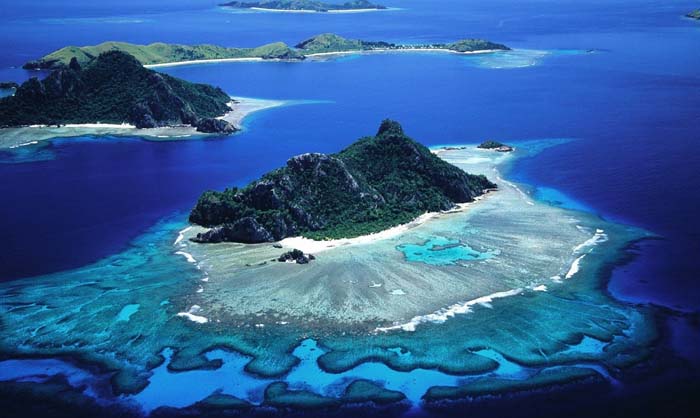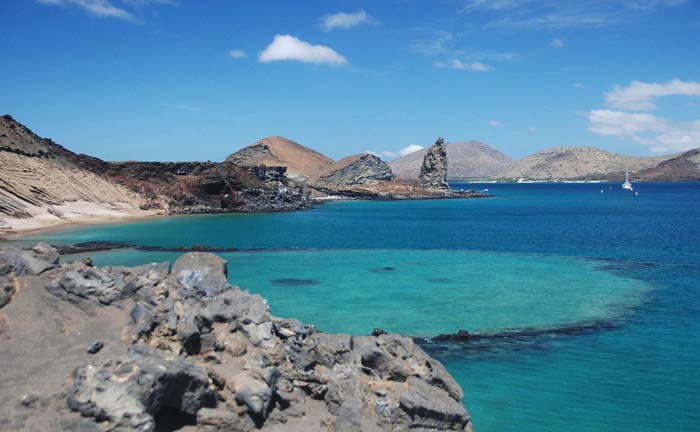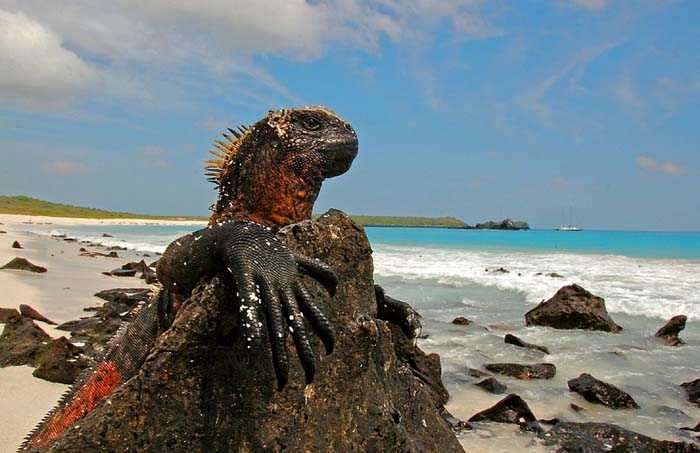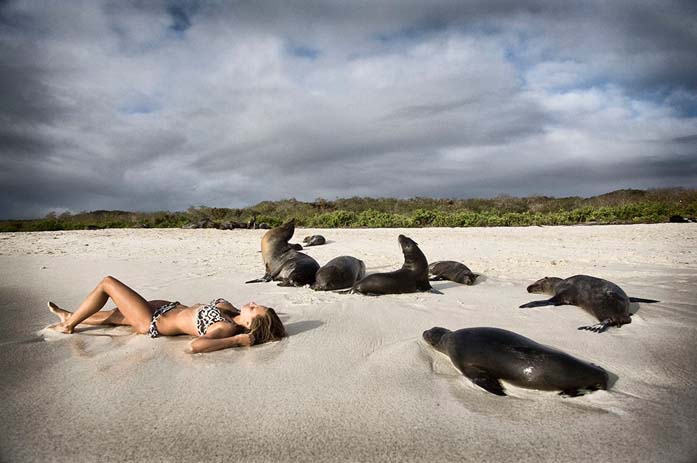
Made famous by Charles Darwin and his revolutionary theory of evolution, the Galapagos islands is the kind of destination that can completely change the way you view the world. Situated some 1000km west of its parent country, Ecuador, in the vast expanse that is the Pacific Ocean, the absolute isolation of these islands has resulted in unique and fearless wildlife that draws travellers from all around the world.
Nowhere else can you come face-to-face with giant tortoises, sea lions or iguanas that treat humans as mere parts of the background. Many of the species here can be seen, approached and photographed without fear of disturbing the creature or putting yourself in harm’s way. Both above and below sea level, the creatures look and act differently to anywhere else on the planet.
Though the wildlife is reason enough to visit these fantasy islands, the Galapagos is also well-known for its stunning natural scenery, sustainable tourism practices and wide range of adventure activities. There is no shortage of reasons to visit the Galapagos and there is no shortage of experiences that will astound you. The key is to know what to do, where to go and how to use your time on these islands to the fullest
The best time for visiting the Galapagos Islands

With the main attractions of the Galapagos being outdoors, it’s crucial to pick the right time of year to visit. Different types of wildlife are active at different times throughout the year so those who want to see particular species should research them individually.
The peak tourist season is in the months from December to May when both the water and air are much warmer, but this is also the rainy season and there will be periods during this time that it rains every day. Animals both on and off the land are less active and the crowds in peak season can compromise the experience of isolation that these islands offer.
From June through November the Humboldt Current brings cold water and cold weather to the Galapagos from the southern tip of South America. The winds are strong at this time of year and the seas rough, but the current also brings nutrient rich waters and plankton that stimulate the marine and over water wildlife. Whale sharks can be seen and divers claim that this is the best time of year for snorkeling and diving. The months from June to August are also the best times to see most of the island’s on-land fauna as they are more active during these mating months.
MORE: 19 INCREDIBLE PLACES TO DIVE AROUND THE WORLD
How to get to the Islands

The Galapagos Islands can only be accessed by plane from either Guayaquil or Quito airport on mainland Ecuador. From here you can choose one of two options. The first is to fly to Isla Baltra Airport, which is about two hours by boat from Puerto Ayora, the main settlement of the Galapagos on Santa Cruz Island. You can also fly to Isla San Cristobal Airport in the capital of the Galapagos region Puerto Baquerizo Moreno. Both of these towns will surprise visitors expecting island huts with their level of development, though the wildlife within immediately set them apart from the regular coastal town.
Flights depart from Quito more frequently, though there are often cheaper options out of Guayaquil. The cost is usually between $350 and $550 USD for a round-trip ticket (one-way tickets are not permitted) depending on how close to peak season you are visiting.
Where to stay on Galapagos

Only four of the 15 islands of the Galapagos are inhabited and of those only two of the settlements have any range of accommodation available for tourists. The first is Puerto Ayora, which has the biggest population of any settlement in the Galapagos. The accommodation mainly caters to backpackers and those seeking cheaper options but there are a few upmarket lodges just outside town for those seeking a bit of comfort. The second is Puerto Baquerizo Moreno, which is less developed than Puerto Ayora and caters almost exclusively to the backpacker market.
The more common accommodation for tourists visiting the Galapagos is actually on the water, with almost all visitors jumping on a boat for at least a few nights of their trip. It’s really the only way to see and appreciate these islands and the lack of accommodation choices on-land means more and more people are taking to luxury yachts and cruisers.
What to you should do on the Galapagos Islands

The Galapagos is all about the wildlife and that is why booking a boat tour of the islands is the best possible thing to do there. You simply cannot get access to the bold and unique animals that live on them without taking a boat and strict regulation of the natural environment here means there is no point even trying. Most people book their places well in advance from their home countries for convenience. This is a good idea as boats are usually full during the high season but booking from overseas is often considerably more expensive than booking in Puerto Ayora or Puerto Baquerizo Moreno.
When booking your boat tour you should consider a few things before making your decision. Firstly, make sure that the trip itinerary is designed to showcase the diversity of the Galapagos by combining different islands and areas. Visits to the islands are only permitted during the hours from 6am to 6pm so you should also ensure that there is sufficient activity planned for you during these hours. If the price you are being quoted seems a lot lower than others check what is included in the price, as many tours don’t include the $100 park entry fee or use of wetsuits and kayaks. Lastly, be sure to investigate what type of boat you will be on. The quality of the boats varies widely and it may affect your comfort, travel times and safety.

The second thing you simply must do in this part of the world is get in the water and take a look at one of the most beautiful and colourful marine ecosystems in the world. Life under the water in the Galapagos is rich and snorkeling and diving are both very popular activities. In addition to the whale sharks that form the biggest attraction you can see manta rays, sea turtles, huge schools of tuna, sea lions and more.
Most of the islands are off-limits without a naturalist guide, but it is possible to travel by speedboat between Isla San Cristobal, Isla Santa Cruz and Isla Isabela. There are organised local day trips in the towns on these islands or you can investigate within the town limits by yourself.

